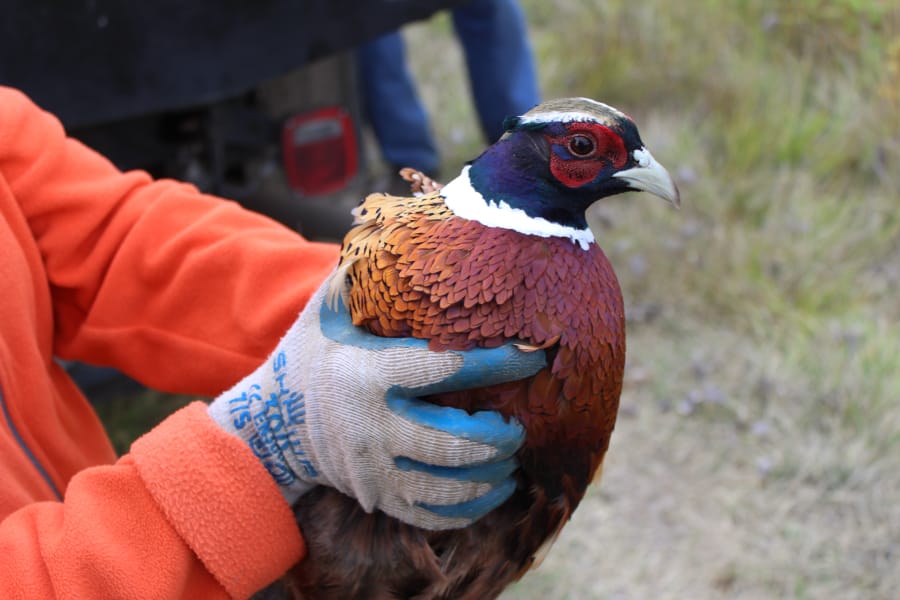The big, colorful rooster pheasant burst into the air, cackling derisively as he rose. His brilliant colors flashed in the sun, and we could see his iridescent feathers in surprising detail. He coasted along and finally went down into the cover about 200 yards in front of us.
“That’s a good one,” said Randy Dalton, a volunteer with the Vancouver Wildlife League. “Someone is going to have fun with that bird tomorrow.”
Julie Rouzee, his partner in the endeavor and another volunteer from the wildlife league, agreed.
The pair were releasing pheasants ahead of the annual youth hunt held every year at the Shillapoo Wildlife Area, and I had come along for the ride. A total of 300 pheasants were being released ahead of the hunt.
The birds were raised at the state game farm in Chehalis and had been trucked down here by Rouzee, who is overseeing the releases for the league this year. The two volunteers then spent about two hours spreading the birds over as much area as they could.
On the morrow, the youth hunters would search for the birds and try to bag one or two.
Upland opportunity
Due to the cool wet climate and the lack of grain farming, naturally sustained pheasant populations are limited in Western Washington.
That is why the state now offers a released pheasant hunt in selected areas of the western third of Washington. The purpose of the program is to provide upland bird hunting opportunity in an area that does not offer much in the way of wild game.
Every year approximately 35,000 to 40,000 male and female pheasants are released at wildlife areas and other public access sites for hunters to target across Western Washington.
Raising and releasing that many birds is hard work, and it is not easy. That is where the volunteer muscle, such as Rouzee and Dalton, comes in.
The youth event was held by the wildlife league last Sept. 22-23. The youth hunt was followed by the senior pheasant hunt, from Sept. 24-28 for hunters over 65.
The general season opened for all other hunters on Sept. 29.
Rouzee and Dalton drove the truck filled with crates of pheasants across the wildlife area, and between bits of friendly banter, released a mix of rooster and hen pheasants into as many different habitats as they could.
The brightly-colored roosters and the plain, brownish hens were incredible flyers for being raised at a game farm. Many of them flew strongly for long distances before settling in to the cover.
The release was planned for the last hours of daylight for a couple reasons. If it is almost dusk the birds will settle in quickly where they are released, instead of roaming off the public land to nearby private lands.
Also, the longer they are out there they are vulnerable to natural predators such as coyotes and hawks.
Predation is an issue. “We figure we lose about 10 percent of the pheasants to predators,” said Dalton.
Dalton and Rouzee are ardent upland bird hunters themselves, and they discussed the quality of the birds as they flew off. Both commented on the size and flying ability of the state-farm-raised birds.
“For the last two years they have been in great condition,” Rouzee said. “They fly great and they are cacklers. They are a lot of fun to hunt.”
Chris White of the WDFW manages the game farm in Chehalis, and he reports that while the birds are fat and strong when released, they may not stay that way if they are on the wildlife area for any length of time.
“The majority of the birds are in great shape when they are released,” he said, “but it takes time for them to find food and get used to the area. They need to find food and water.”
“By the time they are out there for a while, some of the birds are not in great condition.”
However, he reports that most of the birds end up getting harvested pretty quick. There is little to no hold-over.
That is why the plantings are spread out over time. There are two releases a week: on Tuesday and Friday evenings, and this is done over a two-month time period.
About 3,600 to 4,000 pheasants will be released over the season at Shillapoo.
Two releases a week over two months makes for a lot of work for the volunteers. However, Rouzee, Dalton and the others feel it is worth the work to provide the community with a quality bird hunt close to home.
As the last of the birds settled into the covers, the setting sun turned the western sky into gold and orange. Rouzee and Dalton strapped down the empty crates and gathered their gear. The state truck still needed to be driven back to Chehalis, where it would be loaded for the next run.
The program is very popular, and Saturdays and Wednesdays are usually crowded. Hunters can avoid the crowds by hunting on other days, or waiting until the afternoon, when many hunters have left.
Regulations: A Western Washington pheasant license is required to hunt pheasants in the region. A small game license is not required. The Western Washington pheasant license costs $84.50 for adults and $40.50 for youth (under 16). A three-day permit is also offered for $40.50 for residents.
The bag limit is two pheasants of either sex per day.
Steel shot is required for all hunting on the Shillapoo Wildlife Area. Hunter orange is required when hunting the release sites. Hunting is allowed from 8 a.m. to 4 p.m. every day of the season, which runs until Nov.30.
For more information: Call the WDFW Wildlife Program at (360) 902-2515. Or, go to the website for information and maps of the release sites: https://wdfw.wa.gov/hunting/pheasant/western/




